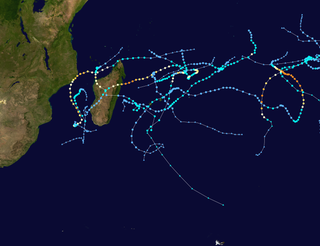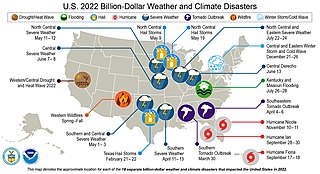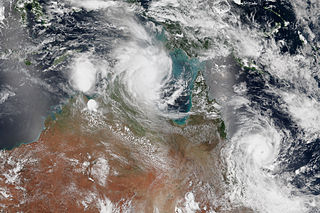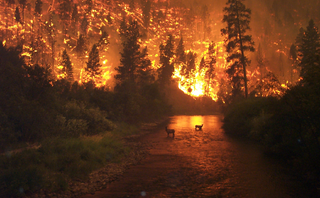
The 2007–08 South-West Indian Ocean cyclone season was the third most active tropical cyclone season, along with the 1985–86 season and behind the 1993–94 season and the 2018–19 season, with twelve named tropical cyclones developing in the region. It began on November 15, 2007, and ended on April 30, 2008, with the exception for Mauritius and the Seychelles, which ended May 15. These dates conventionally delimit the period of each year when most tropical cyclones form in the basin, which is west of 90°E and south of the Equator. Tropical cyclones in this basin are monitored by the Regional Specialised Meteorological Centre in Réunion.

Severe weather is any dangerous meteorological phenomenon with the potential to cause damage, serious social disruption, or loss of human life. Types of severe weather phenomena vary, depending on the latitude, altitude, topography, and atmospheric conditions. High winds, hail, excessive precipitation, and wildfires are forms and effects of severe weather, as are thunderstorms, downbursts, tornadoes, waterspouts, tropical cyclones, and extratropical cyclones. Regional and seasonal severe weather phenomena include blizzards (snowstorms), ice storms, and duststorms.

The 2018–19 South-West Indian Ocean cyclone season was the costliest and the most active season ever recorded. Additionally, it is also the deadliest cyclone season recorded in the South-West Indian Ocean, surpassing the 1891–92 season in which the 1892 Mauritius cyclone devastated the island of Mauritius, and is mainly due to Cyclone Idai. The season was an event of the annual cycle of tropical cyclone and subtropical cyclone formation in the South-West Indian Ocean basin. It officially began on 15 November 2018, and ended on 30 April 2019, except for Mauritius and the Seychelles, which it ended on 15 May 2019. These dates conventionally delimit the period of each year when most tropical and subtropical cyclones form in the basin, which is west of 90°E and south of the Equator. Tropical and subtropical cyclones in this basin are monitored by the Regional Specialised Meteorological Centre in Réunion.

The following is a list of weather events that occurred on Earth in the year 2020.
In 2024, tropical cyclones will form in seven major bodies of water, commonly known as tropical cyclone basins. Tropical cyclones will be named by various weather agencies when they attain maximum sustained winds of 35 knots. So far, thirty systems have formed, with nineteen of them being named. The most intense storm of the year so far is Djoungou, with a minimum pressure of 922 hPa (27.23 inHg). Among this year's systems, so far, five have intensified into major tropical cyclones, with no tropical cyclones intensifying into Category 5 tropical cyclones on the Saffir–Simpson scale (SSHWS). The accumulated cyclone energy (ACE) index for the 2024 so far, as calculated by Colorado State University (CSU), is 119.2 units overall.

The following is a list of weather events that occurred in 2021. The year began with La Niña conditions. There were several natural disasters around the world from various types of weather, including blizzards, cold waves, droughts, heat waves, tornadoes, and tropical cyclones. In December, powerful Typhoon Rai moved through the southern Philippines, killing 410 people and becoming the deadliest single weather event of the year. The costliest event of the year, and the costliest natural disaster on record in the United States, was from a North American cold wave in February 2021, which caused $196.4 billion (USD) in damage; the freezing temperatures and widespread power outages in Texas killed hundreds of people. Another significant natural disaster was Hurricane Ida, which struck southeastern Louisiana and later flooded the Northeastern United States, resulting in $70 billion (USD) in damage. December saw two record-breaking tornado outbreaks, only four days apart from each other. In Europe, the European Severe Storms Laboratory documented 1,482 weather-related injuries and 568 weather-related fatalities. The National Oceanic and Atmospheric Administration documented 796 weather-related fatalities and at least 1,327 weather-related injuries in the United States and the territories of the United States.

The following is a list of weather events that occurred on Earth in the year 2022. The year began with a La Niña. There were several natural disasters around the world from various types of weather, including blizzards, cold waves, droughts, heat waves, wildfires, floods, tornadoes, and tropical cyclones. The deadliest weather event of the year were the European heat waves, which killed over 26,000 people, 11,000 of which were in France. The costliest weather event of the year was Hurricane Ian, which caused at least $112.9 billion in damages in Florida and Cuba. Another significant weather event was the Pakistan floods, which killed 1,739 people and a total of $14.9 billion in damages.
The following is a list of weather events in 2019.

The following is a list of weather events that occurred in 2018.

The following is a list of weather events that occurred in 2017.

The following is a list of weather events that occurred in 2016.

The following is a list of weather events that occurred on Earth in the year 2002. There were several natural disasters around the world from various types of weather, including blizzards, cold waves, droughts, heat waves, tornadoes, and tropical cyclones. The deadliest disaster was a heat wave in India in May, which killed more than 1,030 people. The costliest event of the year was a flood in Europe in August, which killed 232 people and caused €27.7 billion (US$27.115 billion) in damage. In September, Typhoon Rusa struck South Korea, killing at least 213 people and causing at least ₩5.148 trillion (US$4.2 billion) in damage.

The following is a list of weather events that occurred on Earth in the year 2004. There were several natural disasters around the world from various types of weather, including blizzards, cold waves, droughts, heat waves, tornadoes, and tropical cyclones. The deadliest disaster was Hurricane Jeanne, which killed more than 3,000 people when it struck Hispaniola, mostly in Haiti. This was just four months after flooding in Hispaniola killed 2,665 people. Jeanne was also the fourth hurricane to strike the United States in the year, following Charley, Frances, and Ivan. Ivan was the costliest natural disaster of the year, causing US$26.1 billion in damage in the Caribbean and the United States.

The following is a list of weather events that occurred on Earth in the year 2015. There were several natural disasters around the world from various types of weather, including blizzards, cold waves, droughts, heat waves, tornadoes, and tropical cyclones.

The following is a list of weather events that occurred on Earth in the year 2023. The year saw a transition from La Niña to El Niño, with record high global average surface temperatures. The several weather events which had a significant impact were blizzards, cold waves, droughts, heat waves, wildfires, floods, tornadoes, and tropical cyclones.

The 2023–24 South-West Indian Ocean cyclone season was an average season, including eleven named storms, five tropical cyclones and two intense tropical cyclones. Despite its moderate activity, it was the least deadly and destructive season in two years. It is the current event of the annual cycle of tropical and subtropical cyclogenesis. It began on 15 November 2023, and ended on 30 April 2024, with the exception for Mauritius and the Seychelles, where it ended on 15 May 2024. These dates conventionally delimit the period of each year when most tropical and subtropical cyclones form in the basin, which is west of 90°E and south of the Equator. However, tropical cyclones can form year-round, and all tropical cyclones that will form between 1 July 2023 and 30 June 2024 will be part of the season. Tropical and subtropical cyclones in this basin are monitored by the Regional Specialised Meteorological Centre in Réunion and unofficially by the Joint Typhoon Warning Center.

The weather of 2012 marked the fewest fatalities from natural disasters in a decade, although there were several damaging and deadly floods, tropical cyclones, tornadoes, and other weather events. These include blizzards, cold waves, droughts, heat waves, and wildfires.

Severe Tropical Storm Alvaro was a tropical cyclone that traversed over Madagascar during New Year's Day. The first named storm of the 2023-24 South-West Indian Ocean cyclone season, Alvaro originated as a tropical disturbance at the Mozambique Channel. Being forecasted to develop into a moderate tropical storm, the disturbance was in a favorable environment for intensification. Tracking southeast, the system was upgraded into a tropical depression on December 31. It later intensified into a tropical storm, receiving the name Alvaro. Alvaro continued to move and intensify despite vertical wind shear. On January 1, Alvaro further intensified into a severe tropical storm before making landfall over Morombe District, Madagascar. It weakened back to a tropical depression after passing over the mountainous terrain of the island nation. Alvaro re-entered again to the Indian Ocean and intensified back into a moderate tropical storm. Shortly after reintensification, strong wind shear prevented any further development of the storm. Alvaro later transitioned into a post-tropical depression, being last noted on January 4.

The following is a list of weather events that occurred on Earth in the year 2000. There were several natural disasters around the world from various types of weather, including floods, droughts, heat waves, tornadoes, and tropical cyclones. The deadliest disaster were the 2000 Mozambique Floods which killed 800 people, and the costliest event of the year was Typhoon Saomai, which caused $6.3 billion in damages.

















